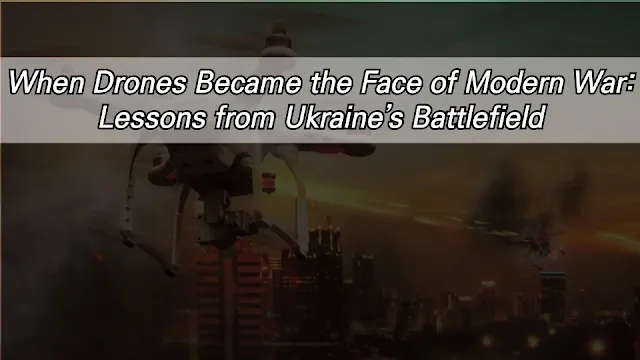The ongoing war in Ukraine has become a defining case study in the evolution of modern warfare. Drones, once associated primarily with commercial or recreational use, have rapidly become central to military operations. Their proliferation on the battlefield has fundamentally altered strategies, tactics, and the daily realities faced by soldiers.
The Rise of Kamikaze and FPV Drones: Small Machines, Massive Impact
The introduction of kamikaze drones—also known as loitering munitions—and FPV (First Person View) drones has significantly shifted the balance of power on the battlefield. Both Ukrainian and Russian forces have deployed these drones in large numbers, often assembling them from commercial components or adapting civilian models for military use.
FPV drones, guided in real time by operators using video feeds, are capable of striking high-value targets with precision. A single FPV drone, costing only a few thousand dollars, can destroy armored vehicles, air defense systems, or fortified positions worth millions. This has led to a situation where the destruction of expensive military assets can be achieved at a fraction of their value, undermining traditional assumptions about the relationship between cost and effectiveness in warfare.
The widespread use of kamikaze drones has also forced changes in defensive tactics. Armored vehicles and artillery units that once relied on mobility and camouflage now face persistent threats from above, requiring new forms of protection and constant vigilance. The psychological impact on soldiers—knowing that a silent, low-flying drone could appear at any moment—has added a new layer of tension to frontline service.
Eyes in the Sky: Surveillance and Precision Strikes
Surveillance drones have become indispensable tools for both reconnaissance and targeting. These drones provide continuous, real-time intelligence on enemy movements, supply routes, and defensive positions. The data collected is used to direct artillery fire, coordinate attacks, and monitor changes in enemy deployments.
The effect of this persistent aerial surveillance is profound. The battlefield has become increasingly transparent, with few opportunities for large troop movements or surprise maneuvers. Soldiers and commanders must now operate under the assumption that their actions are being observed and recorded at all times. This has led to a shift toward smaller, more dispersed units, as well as the adoption of camouflage and concealment techniques tailored to evade drone detection.
Moreover, the integration of surveillance drones with precision-guided munitions has increased the lethality of artillery and missile strikes. Targets can be identified, confirmed, and engaged within minutes, reducing the window for enemy forces to reposition or take cover. The result is a battlefield environment where speed, adaptability, and information dominance are critical to survival.
Drones as Lifelines: Resupply, Rescue, and Automation
Beyond their offensive and reconnaissance roles, drones are now essential for logistics and support operations. In Ukraine, drones are routinely used to deliver ammunition, food, water, and medical supplies to front-line positions that are otherwise inaccessible or too dangerous for human couriers. This capability has proven vital in sustaining units operating under constant threat of attack.
In some cases, drones have also been adapted for casualty evacuation, providing a means to retrieve wounded soldiers from exposed locations without risking additional lives. The scale of drone deployment is notable: reports indicate that over a million drones have been used in Ukraine in a single year, with production and innovation continuing to accelerate.
The use of unmanned ground vehicles and boats is also expanding, further automating tasks that would otherwise expose personnel to significant risk. This trend toward automation is reshaping not only how supplies are delivered but also how future conflicts may be fought, with increasing reliance on remotely operated and autonomous systems.
The Cat-and-Mouse Game: Countermeasures and Tactical Evolution
The rapid adoption of drones has sparked an equally rapid development of countermeasures. Electronic warfare units are deployed to jam drone communications, and physical barriers such as nets are installed over critical infrastructure and troop positions. Both sides are investing in new technologies to protect against aerial threats, including anti-drone weapons and software designed to detect and disrupt drone operations.
Russia, for example, has introduced fiber-optic drones that are resistant to electronic jamming, while Ukraine has responded by modifying drone designs and tactics to overcome these defenses. This ongoing cycle of innovation and adaptation has contributed to a tactical stalemate in some areas, as each side seeks to gain a temporary advantage before the other responds.
The result is a dynamic and unpredictable battlefield, where success often depends on the ability to rapidly develop and implement new solutions. The interplay between drone technology and countermeasures is now a central feature of modern conflict, influencing both operational planning and the broader trajectory of the war.
The Dawn of a New Era
The use of drones in Ukraine has demonstrated their transformative potential in modern warfare. Drones have shifted the balance between cost and effectiveness, expanded the scope of surveillance, and introduced new possibilities for logistics and support. At the same time, they have driven a cycle of innovation that continues to shape the conduct of military operations.
As the conflict continues, the lessons learned on the Ukrainian battlefield are being closely studied by militaries around the world. The integration of drones into all aspects of warfare is likely to accelerate, raising important questions about the future of conflict, the role of automation, and the balance between offense and defense.
The age of the drone is here, and its impact on the nature of war is only beginning to be understood.

